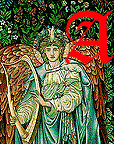
fter the early atheism described in the letter to Ruskin quoted above, Hunt had a religious conversion, which he claimed to have recorded in The Light of the World. (See Landow, "William Holman Hunt's 'The Shadow of Death,'" Bulletin of the John Rylands University Library of Manchester, 55 (1972), 212-15). although his correspondence and diaries make clear that after his conversion he remained a sincere believer, it is difficult to define precisely the nature of that belief - something of importance here in interpreting the basic significance of some of his works. For example, if one believes that Hunt shared major points of belief with the Broad Church party, then pictures as different as The Shadow of Death and Melchizedek become, in part, mystical symbols of the sacrament of communion. But if, as I argue, Hunt was closest to the Evangelicals, The Shadow of Death conveys primarily a type of the Crucifixion and Melchizedek notes a radically Protestant comment on the idea that each believer is a priest of Christ.

Thomas Combe W. Holman Hunt Chalk on paper? Source: Pre-Raphaelitism, II, 182
The important problem of thus defining Hunt's belief is complicated by the fact that he had long and continuing associations with members of all three groups in the Church of England. Thus, although he later seems to have held the High Church party (and the art it sponsored) in distaste, early in his career he painted a High Church Fellow of Jesus College, Oxford, and his great and continuing friend Thomas Combe introduced him to friends in High Church colleges in the University. In the 1860s Hunt was even commissioned to design the stained-glass window of Melchizedek by another High Church friend, Beamont, who was Vicar of St. Michael and All Angels, Cambridge. The dedication of the church clearly indicates that Evangelicals would be unhappy there.
More important, the painter shared some important points of belief with the Broad Church and had many friends among its adherents — just as he did among virtually every variety of believer and non-believer. As Horton Davies has pointed out in a private communication: "We know that Hunt was a good friend of Tennyson, a stalwart of the Broad Church party, and that he once went with the poet on a walking holiday in Devon and Somerset. The Broad Church party was ironically "a party to end parties in the Church" — that would have appealed to Hunt who hated ecclesiasticism. The Broad Church party also had a very great respect for the working man and for the dignity of labor, attitudes which inform The Shadow of Death. The founders of the party, like Frederick Denison Maurice, were England's first Christian Socialists. We recall that the originating and dynamic phase of Christian Socialism was from 1848 to 1854, which coincides with the crucial years of the Pre-Raphaelite Brotherhood. This party was not literalistic in its interpretation of Holy Scripture, as were the Evangelicals, but accepted the humanity of Jesus with greater seriousness than either of the other two Church of England parties."
Nonetheless, as his letters to J. L. Tupper show, Holman Hunt did not take seriously the sacrament of baptism, which was important to Broad and High Church parties but not Evangelicals; and Hunt's emphasis on strict morality, personal conversion, and typology all convince me he shared more major points of belief with the Evangelicals than with other parties. His conception of the Bible also seems to have been far more literalist than that of the Broad Church. On Hunt's Evangelical belief and its influence on his art, see "The Act of Painting as Religious Exercise; or Painting as Penance" and "The Religious Significance of Holman Hunt''s "Realism"" in "Hunt's 'The Shadow of Death,'", 204-10, 222-7.
Created December 2001 Last modified 13 January 2022
